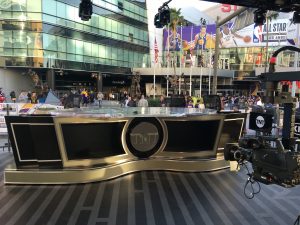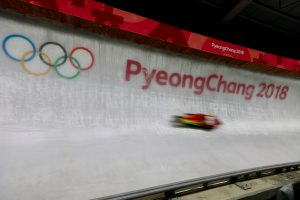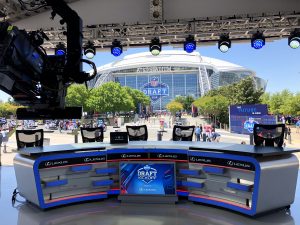Road Warriors 2018, Part 1: The Top Sports-Production Highlights of the Year
A review of some of the biggest events on the sports-production calendar
Story Highlights
2018 was one of the most eventful years for sports production in recent memory, with the 2018 PyeongChang Olympics and 2018 FIFA World Cup capturing the nation’s attention over the summer and annual events like the College Football Playoff National Championship Game, Super Bowl, NFL Draft, and others breaking production records and test-driving new technologies and workflows. As if there weren’t enough going on stateside, this year’s Road Warriors features an expanded look at what went on across the Atlantic. Here is Part 1 of SVG’s a look at some of the sports-production highlights from the past year (CLICK HERE for Part 2).
COLLEGE FOOTBALL PLAYOFF NATIONAL CHAMPIONSHIP GAME
Mercedes-Benz Stadium, Atlanta
January 8
The CFP National Championship Game on ESPN featured the biggest production ever for a bowl game, thanks to the use of 125 cameras (between game, studio, and MegaCast coverage) and a game production coming out of nine Game Creek Video remote-production units. Camera and audio developments brought the viewer closer than ever to Alabama’s come-from-behind OT victory over Georgia.
“The personal highlight is seeing it all come together,” said John LaChance, director, remote production operations, ESPN, during the lead-up to the massive effort, which capped the 2017 college-football season. “To see the new angles, perspectives, and gadgets we are introducing and watch those get integrated from paper to plan to [execution] gives us a great sense of pride. And it’s a partnership between those technicians, vendors, and production personnel.”
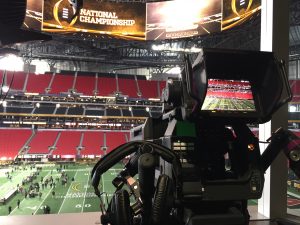
ESPN deployed 125 cameras to capture the CFP National Championship action at Mercedes-Benz Stadium in Atlanta.
A new element in the production was a small RF camera that 3G Wireless installed in each of the four down markers on each side of the field. It had been tested at the Celebration Bowl and the Sugar Bowl.
“The cameras are on the top side of the first-and-10 markers and will offer viewers angles they have not seen in the past,” LaChance explained. “It’s a perspective right from the sideline, and they can see whether a player made the first down.”
Also new were two hat cams: cameras mounted in the caps of two of the folks who moved the chains up and down the field. According to LaChance, the cameras did not require bodypacks, making them lighter and less obtrusive when worn by officials on the move.
The eight pylon cams also got a lift, with a microphone placed in the pylon at each corner of the end zones. They offered a total of 28 angles of video coverage.
The specialty cameras complemented the 51 other cameras deployed for game coverage, primarily a mix of Sony HDC-4300, HDC-2500, and HDC-4800 cameras coupled with Canon lenses, including two 95X super-telephotos.
Nine Game Creek mobile production units and support vehicles were onsite: Peacock A and B at the core of the game production, Nitro A and B handling GameDay and SportsCenter needs, Maverick overseeing the MegaCast, Webby on hand for the SEC Network, and Edit 2 and 3 supporting the game and MegaCast. BSI was onsite for RF needs (13 cameras), and PSSI provided satellite-uplink facilities.
LaChance expressed his pride in the work done by everyone involved in getting the production facilities up and running in five days.
“I think we had a great season for ESPN and the games that aired on ABC,” he said. “We had some great finishes, and to be around college football when you are a college-football fan makes the season fly by. But it was a great season, and that is testament to some great technicians, staff, personnel, and vendors who made it come together and great for the folks at home.” — Ken Kerschbaumer and Brandon Costa
CLICK HERE for SVG’s full CFP National Championship Game coverage.
SUPER BOWL LII
U.S. Bank Stadium, Minneapolis
February 4
Each year, the Super Bowl broadcaster looks to up the technological ante at America’s highest-profile sports event. For Super Bowl LII, to put it simply, NBC’s overall presence in the Twin Cities was mind-blowing. And not to be forgotten: just five days after the Philadelphia Eagles won their first Super Bowl title in franchise history, the Peacock embarked on an even larger-scale production in Korea with the Opening Ceremony at the 2018 Olympic Games in PyeongChang, South Korea.
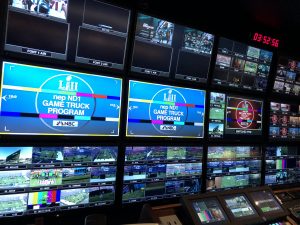
Inside NEP ND1’s A unit, which served as the core of NBC’s Super Bowl LII game production in Minneapolis.
“This has been 2½ years of planning, and we have meticulously walked through every aspect technically and operationally,” said Ken Goss, SVP, remote operations and production planning, NBC Sports Group, prior to the game.
In terms of the game production, camera levels were (not surprisingly) at an all-time high. The 73-camera complement (featuring primarily Canon lenses) included 20 miniature cameras for the Admiral Video PylonCam system added to a bevy of 4K and high-speed systems: four Sony HDC-4800 4K robos, three HDC-4300’s in 4K mode, four HDC-4300’s running at 4X slo-mo, another seven HDC-4300’s running at 6X slo-mo, and two more HDC-4300’s at 8X slo-mo.
NBC once again deployed two SkyCam systems — a low and a high — as it did for selected games in the second half of the season on Sunday Night Football and Thursday Night Football. The camera complement also comprised nearly a dozen robos (provided by Fletcher), including a pair of new positions: an HDC-4800 overlooking the entirety of each end zone to capture close plays along the side or back lines.
With 14 mobile units onsite, NBC Sports was forced to expand its compound beyond the loading-dock area inside U.S. Bank Stadium. Although this is the norm at any Super Bowl, the potential subzero temperatures of a Minneapolis February made an outdoor compound unviable. Therefore, NBC erected a massive climate-controlled tent just outside the stadium to house the overflow trucks.
Inside the primary compound, NEP’s ND1 (A, B, C, and D units) housed the main game production, accompanied by ND4 (A and B) for tape release and additional camera/replay sources. The pregame studio show’s mobile unit, ND7 A and B, was also in the compound. Because there was no room for a full truck, for transmission and distribution management, NBC worked with NEP to build an ESU flypack, which was also located in the compound. — Jason Dachman and BC
CLICK HERE for SVG’s full Super Bowl LII coverage.
NBA ALL-STAR GAME
Staples Center, Los Angeles
February 18
NBA All-Star festivities once again served as a showcase for Turner Sports’ tech-savvy production efforts on the hard court. Included in Turner’s bag of tech toys were an RF pylon cam on the Skills Challenge, shot-tracking technology for the Three-Point Contest, and an even more intricate ecosystem inside its already massive truck compound.
“NBA All-Star really shows what we can do,” said Chris Brown, senior director, technical operations, Turner Sports, during the weekend. “We definitely have a few cool new [production tools] here, but, in terms of the compound, we try not to mess with the secret sauce. We’ve found a [workflow] that works really well for us, so we are just trying to build on that each year. It’s a lot of fun.”
The raucous atmosphere of All-Star Saturday Night tipped off with the Skills Challenge, and fans had a new perspective on the three-round, obstacle-course competition, in which the players dribbled down the sidelines, weaving in and out of pylons. Turner worked with AVS to deploy an RF system featuring a GoPro/Vislink Herocast miniature camera sitting atop two of the pylons.
The pylon cam was just one of a whopping 48 cameras deployed by Turner during the weekend for the All-Star Game, All-Star Saturday Night, Inside the NBA studio sets, and NBA on TNT Road Show concerts throughout the weekend. Also among them were two additional RF cameras (also from AVS) and six robos (from Fletcher).
Turner’s truck compound was located at the top of the steps of the L.A. Convention Center and comprised 13 total mobile units, which arrived on Feb. 8 — more than a week before All-Star Weekend. NEP’s ND1 (A, B, C, and D) was once again at the core of the compound, serving as the audio- and video-routing/distribution center for the entire show.
ND1’s B unit served as the primary distribution point for the compound. All camera and audio feeds were fed into ND1 for distribution to the various trucks. Thanks to ND1’s robust fiber connectivity, the A, C, and D trucks were also able to serve as signal-distribution points for other trucks, shortening the length of cable runs throughout the compound.
In addition, Turner used ND1 for a variety of other needs, including submixing in the B unit’s audio room and transforming the C unit’s EVS replay area into “edit central” to handle its extensive file-based workflows.
In addition to ND1, NEP’s SS24 (A, B, and C) and NCP10 (A and B) were onsite. Throughout the weekend, NCP11 served as home to the Inside the NBA onsite studio show. SS16 and ATU handled the entertainment and halftime-show elements, and Cobalt handled the Turner-Intel virtual-reality production. — JD
CLICK HERE for SVG’s full coverage of the NBA All-Star festivities.
2018 PYEONGCHANG OLYMPICS
South Korea
February 9-25
The athletes weren’t the only ones who put in months of training and preparation ahead of the Winter Olympics. NBC Olympics took its pre-Games preparation to a whole new level, testing and retesting nearly every technical system at its broadcast-production facility in Stamford, CT, prior to their use at the 2018 PyeongChang Games.
“Things are going really well, and it has been a good setup, better than the past three or four Games,” said Dave Mazza, SVP/CTO, NBC Sports Group and NBC Olympics, during the Games. “Our team has been awesome, and, while we had a few snags with people getting sick, fortunately, everyone is doing well now.”
He credited a few things for NBC’s being ahead of where it usually is at that stage of preparation. Olympic Broadcast Services (OBS) and the PyeongChang Organizing Committee for the Olympic Games (POCOG) took construction of the International Broadcast Center (IBC), venues, and facilities to a new level of readiness, especially compared with recent Games. The 2016 and 2014 Olympics in Rio and Sochi, respectively, were plagued with construction delays, equipment shortages for things like outlets and power, transportation issues, and more. That was not the case in PyeongChang.
“The Koreans understand technology,” Mazza noted. “They also do a nice job with construction. And they don’t do anything halfway. At times, we had to tell them, ‘Hey, guys, this is just a temporary setup’ while they were welding something that was designed to last forever.”
This was also the second Games for which OBS had disassembled the previous IBC building, packed it into more than 300 shipping containers, and rebuilt it at the new location.
“All of the panels, columns, and electrical systems were up when we got here. It was a godsend because it took all of the variables out of the equation,” Mazza explained. “Our space was clean, ready to run cables, and the power was good. And, so far, the telco connections have been without incident. Both OBS and the KOBOC have done an excellent job of getting everything ready.”
While OBS and the South Koreans were busy getting the venues and the IBC ready to go, the NBC Olympics team in Stamford was spending months making sure the IBC systems were tested and retested to ensure that they would be ready for the massive workload.
In terms of the technology and the production, the team made a lot of changes on the venue side of operations and a bunch of small tweaks to the IBC operations.
“On the venue side, we took what we have been doing with the at-home efforts in the States and applied it to the venues,” Mazza said. “So we are doing some significant at-home productions in the IBC and also back in the States.”
NBC’s NEWBERT flypack was deployed for hockey coverage from the smaller hockey arena and the Closing Ceremony. The NEWBERT system is contained in six flight cases and includes a good-size Evertz EMR 64 router. The flypack also houses a Lawo-based audio core, a small intercom system, and an EVS replay unit. An AT&T Media Links frame sent 36 feeds from the Closing Ceremony to Control Room X in Stamford through a 10-Gbps link.
The alpine events also made use of some remote connectivity. The core NBC production-truck facilities, provided by Game Creek Video, were located at the speed hill and connected to an eight-camera flypack and a routing switcher located at the technical-skiing venue, where the slalom events were held. Located an hour apart, the production team at the speed hill was able to cut the technical-skiing show, thanks to a 10-Gbps circuit that delivered eight camera feeds and 20-24 split feeds from the host production. — KK and BC
CLICK HERE for SVG’s full coverage of the PyeongChang Games.
NCAA MEN’S BASKETBALL FINAL FOUR
Alamodome, San Antonio
March 31–April 2
In Year 8 of the March Madness partnership between CBS Sports and Turner Sports, Final Four operations ran more smoothly than ever. The most notable change came in the form of a major presence by Game Creek Video. Five mobile units, four supporting the main game production in some capacity, anchored the compound. The new 79, which had debuted just six weeks before, served as host to the main production on TBS.
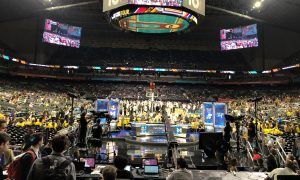
An onsite set in the fan section of the south end of the Alamodome anchored Turner Sports’ pre/postgame and halftime coverage at the 2018 NCAA Men’s Final Four.
“The whole IP routing infrastructure [of 79] is exciting,” said Chris Brown, director, technical operations, Turner Sports, prior to the event. “It changes the workflow a little bit, not drastically. It also makes things like distribution easier. So it’s a great addition to what we have been doing.”
According to Brown, the refreshed IP backbone helped expand the compound’s capabilities and reduce its footprint. What may have taken four or five trucks in previous years was down to three. NEP also had a robust collection of mobile units onsite, supporting both the TeamCasts and other needs. Chromium was home to TBS’s pre/postgame and halftime onsite studio coverage.
Inside the Alamodome were 54 cameras covering action for the main game, supplementing the TeamCasts (which returned for the production), and shooting the onsite studio set positioned at the south end of the arena. Five cameras at Turner’s special set on San Antonio’s iconic River Walk brought the total deployed to 59.
Back in the mix were SkyCam Wildcat, a collection of Sony HDC- 4300 high-speed cameras, Bexel’s Clarity 800 camera (which, for the second year, was positioned at the base of the basket stanchions), and the popular Rail Cam system.
The move to Game Creek Video trucks supporting the main game broadcast also delivered a shot in the arm on the lens front. Canon was out in full force, including CJ12x4.3B lenses on the robotic units atop each backboard. The Rail Cam featured a Canon HJ15x8.5B KRSE-V image-stabilized HD lens, and a pair of pedestal cams boasted DIGISUPER 95 Super Telephotos. — BC
CLICK HERE for full coverage of the NCAA Final Four
NFL DRAFT
AT&T Stadium, Arlington, TX
April 26-28
Each year, NFL Media and ESPN roll out an NFL Draft production that is larger than the previous one — and both took it to a whole new level in 2018 at “Jerry’s World” in Arlington, with Fox Sports also joining the party. With the Draft located in an NFL stadium for the first time and NFL Network’s early-round coverage simulcast on Fox (marking the Draft’s first appearance on broadcast television), NFL Media rolled out its largest Draft production to date at AT&T Stadium.
“We truly have an open canvas [at AT&T Stadium], as opposed to other locations — like Radio City [Music Hall], Chicago, and Philadelphia — which were all great but had their limitations in terms of space,” said Dave Shaw, VP, production, NFL Media, prior to the event. “We’ve got a lot more room to work with here both inside and outside, which makes the setup easier, and we have a much bigger set than in the past.”
Although NFL Network and Fox Sports coverage was co-branded and the on-air talent combined, NFL Media oversaw the entire production in Arlington.
For the second consecutive year, NFL Media rolled out Game Creek Video’s Encore (A, B, and C units) to handle NFL Network’s growing Draft production. It served NFL Network’s two primary sets: the interior set inside AT&T Stadium and the exterior one at the NFL Fan Experience. Game Creek Video’s Pride A and B units were also on hand in the overflow compound outside the stadium, producing Good Morning Football each morning and NFL Network’s Red Carpet Special prior to the start of the Draft on Thursday. NFL Network’s camera complement also continued to grow. The network deployed 32 of its own cameras in Arlington and also took 12 feeds from ESPN.
ESPN’s coverage featured first dual-network coverage of Round 1, with primary coverage airing on ESPN and a College GameDay alternate broadcast on ESPN2 — both of which had onsite sets at AT&T Stadium. As a result, ESPN rolled out its largest NFL Draft production to date, complete with several innovations, including a DigiBoom gimbal-stabilized camera rig. Although the primary show was produced out of NEP EN1 (A, B, C, D, and E units) and GameDay operated independently out of its normal Game Creek Video Maverick unit, the two shows were still heavily intertwined.
“This is really a massive show. I don’t think people realize just how big the Draft really is,” said Senior Ops Manager Steve Carter. “There are always new concepts, ideas, and things that the NFL is looking to do, and then we build out the show from there. It’s a huge challenge, but it’s also very exciting.” — JD
CLICK HERE for SVG’s full NFL Draft coverage.
PLAYERS CHAMPIONSHIP
TPC Sawgrass, Ponte Vedra Beach, FL
May 10-13
With the Players Championship always played at TPC Sawgrass, NBC Sports and the PGA have refined operations over the years, and the improvements continued to be evident.
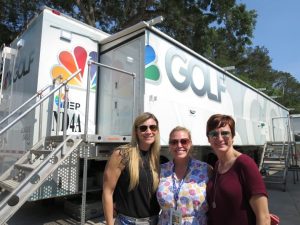
From left: NBC Sports’ Allison McAllister, with Golf Channel’s Amanda Short, senior production manager, and Kristin Xippolitos, senior director, operations
“We know the people, and the working relationships are great,” explained Allison McAllister, director, golf operations, NBC Sports. “Because of that, we just know the ins and outs of the course.”
The biggest improvement to on-course operations for this edition was that there were no longer cable ramps on the course: a lot of effort was put into cutting cable-access paths so that all cables could be buried. In the past, upwards of 40 cable ramps would be on the course, but now the 42 miles’ worth of 12-strand cable were out of sight, an important step for an event that is determined to close the gap with the Masters.
At the core of NBC’s coverage were 62 cameras, including 34 wired hard cameras, 13 wired handhelds (including a jib), four wireless RF mini cameras, three tee-box robos, a POV bunker cam on the 17th hole, one robotic camera in the scoring cabin, three small sub-tower robos, an Inertia Unlimited X-Mo, and a FlyCam between the 16th and 17th holes.
Golf Channel and NBC Sports delivered 90 hours of live programming surrounding the event, and the most notable evolution in its coverage continued to be the rollout of Trackman and Toptracer systems that allow balls to be tracked as they fly.
NEP’s ND4/Double Eagle was the main production truck, with SS24 handling the additional camera and replay resources required for the larger golf tournaments. Also on hand were NEP ESU and ND7, producing Live From, which used 13 dedicated cameras, and Launchpad for DirecTV, focused on the 14th hole. CP Communications’ HD11 unit oversaw RF demands.
“NEP does a tremendous job for us engineering-wise,” said Ken Goss, SVP, remote operations and production planning, NBC Sports. “We continue to be very happy with their facilities, and the R&D and support we get from them on the other golf tournaments and events really pay off for these bigger shows. We just had the Kentucky Derby and then right to here, so we’re off to a successful start to our championship season, and it’s because of our partnership with NEP.”— KK
CLICK HERE for SVG’s full coverage from The Players.
